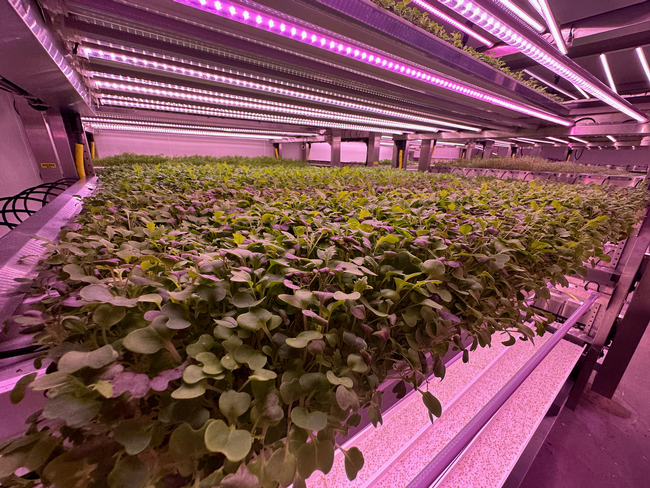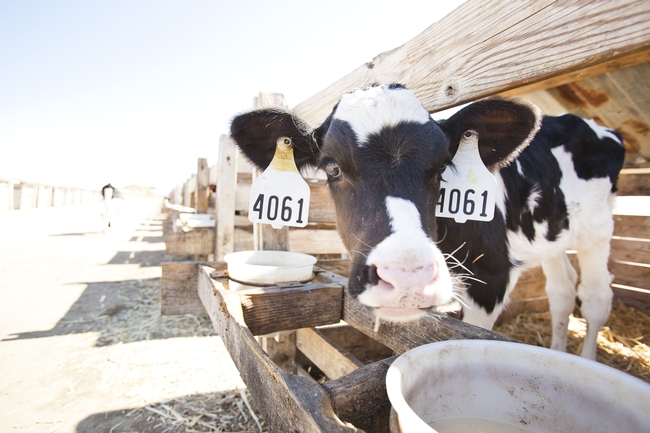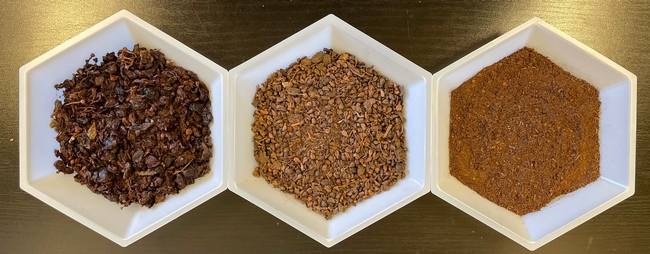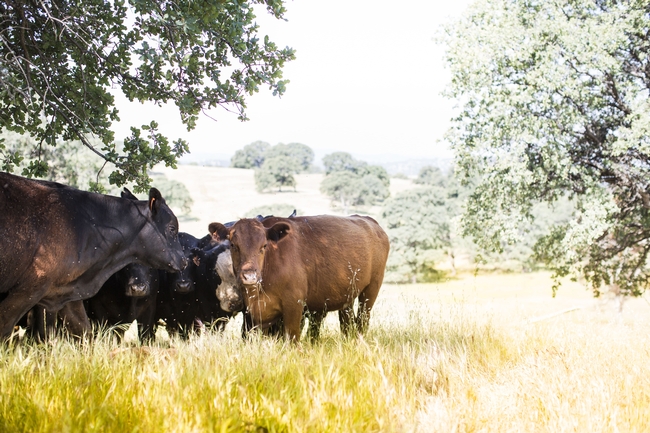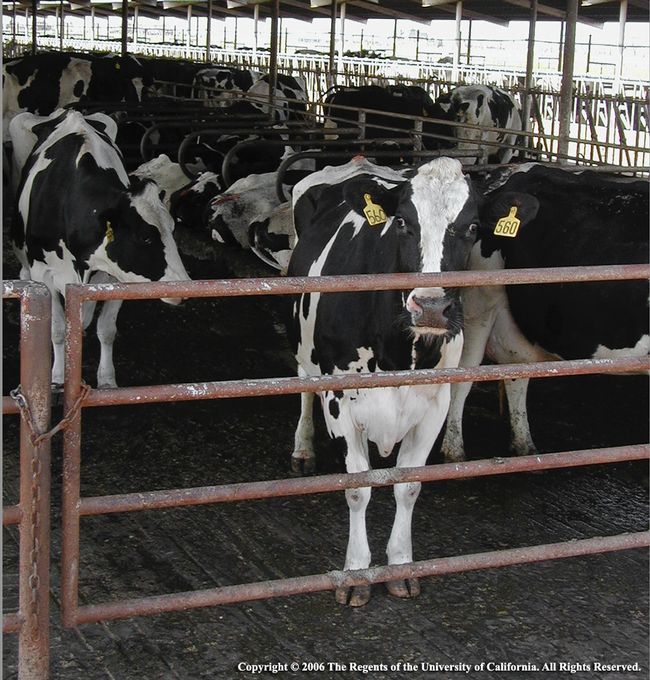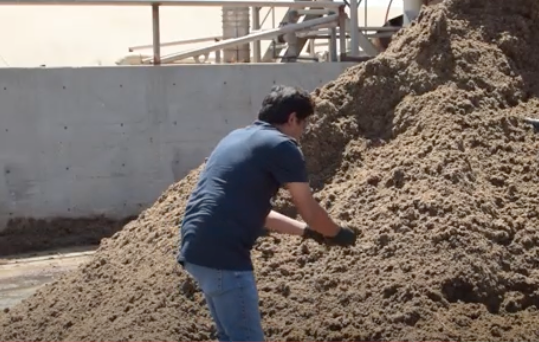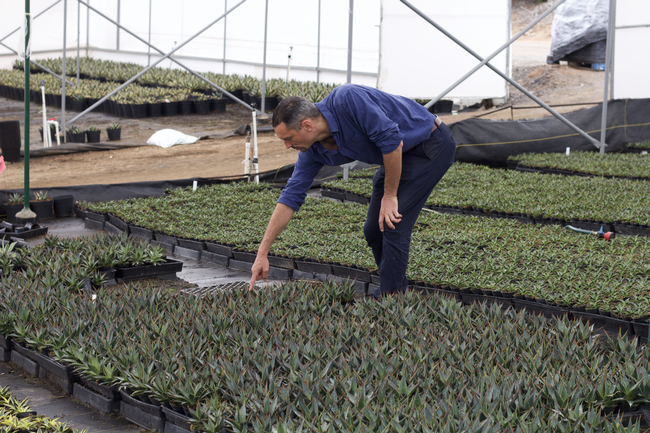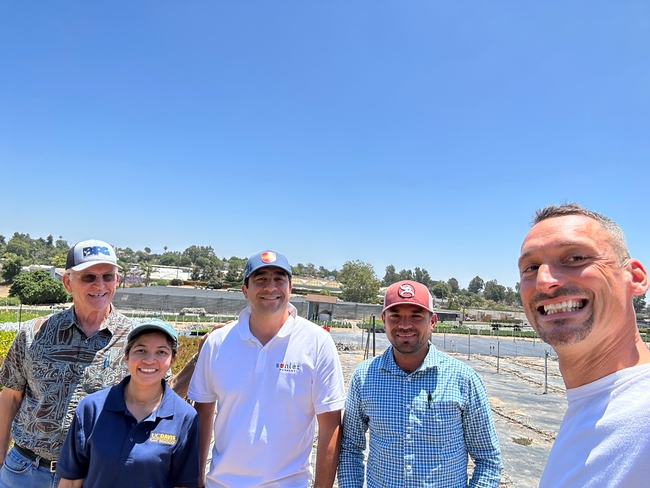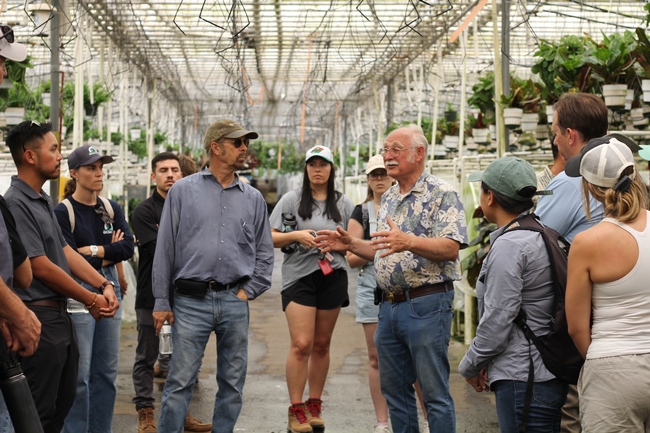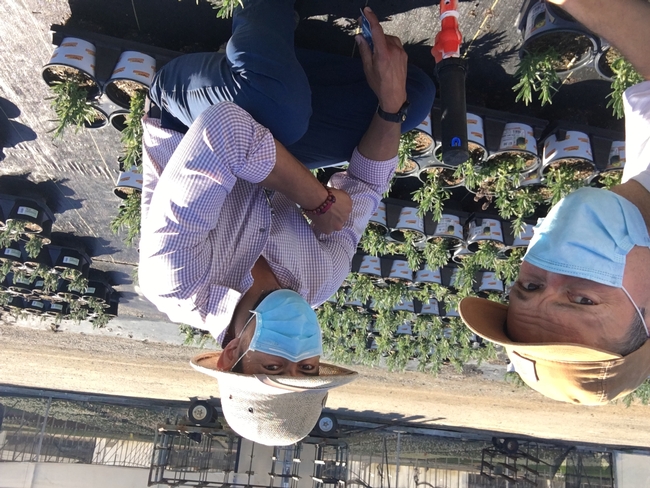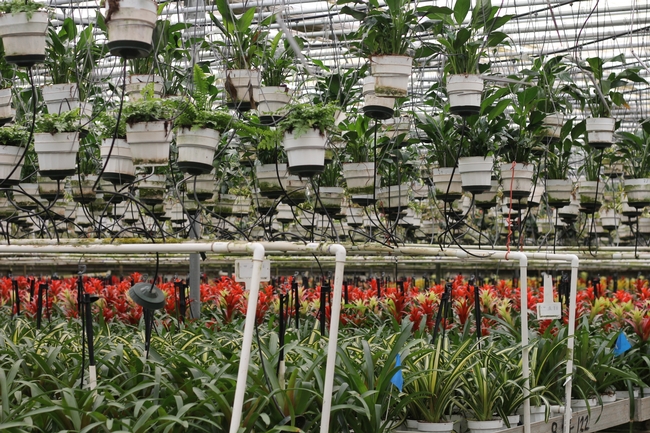Posts Tagged: greenhouse
Controlled environment agriculture courses offered online
UC Davis Continuing and Professional Education and The VINE launch indoor farming classes
A new, comprehensive and advanced learning experience in indoor farming is now available for growers. The VINE, an initiative of University of California Agriculture and Natural Resources (UC ANR), and UC Davis Continuing and Professional Education have opened enrollment for their new Controlled Environment Agriculture Program. Courses begin on July 1.
Controlled environment agriculture is a technology-based method of growing plants that offers precise control over temperature, humidity, light, carbon dioxide and air circulation. CEA can take place in greenhouses, indoor vertical farms or hydroponic farms.
"Unpredictable and extreme weather, pests and growing demand for year-round, local produce are driving growers to move crop production indoors,” said Gabe Youtsey, UC ANR chief innovation officer and co-founder of the VINE.
The CEA Program is designed to impart a deep understanding of both the scientific and practical aspects of indoor farming. The series of four detailed courses, designed to be completed in less than a year, are offered through a flexible online platform. This program is suitable for a wide range of professionals from various sectors including farming operations managers, horticulturists, indoor farming specialists, early-career agriculture professionals, and those in related fields.
"As the agricultural sector evolves, our CEA Program aims to provide the foundational knowledge and practical skills crucial for success in controlled environment agriculture," said Youtsey. "We are preparing participants to effectively manage and innovate within their own agricultural practices."
Participants in the program will receive instruction from international experts in controlled environment agriculture. The curriculum includes an exploration of various business models in CEA, optimal crop selection for different environments, and effective strategies for managing pests and diseases. Additionally, it covers the application of data to enhance growing conditions and profitability, as well as best practices for ensuring product safety and quality.
"Students in this program will gain a deeper understanding of the operational aspects of indoor farming and how they can apply this knowledge to real-world scenarios," said Jennifer Greenier, Ph.D., UC Davis Life Sciences Workforce Development director. "We are committed to providing educational pathways that nurture the skills necessary for advancing career opportunities in agriculture."
The Controlled Environment Agriculture Program is structured around four core courses, each designed to build specific skills and knowledge essential for success in indoor farming:
- Introduction to CEA – Fundamentals of indoor farming, business models, and technological advancements.
- Plant Production in Indoor Farming – Planning and implementing effective operations, understanding plant physiology, and nutrition management.
- Postharvest Processes: Ensuring Crop Quality and Safety in CEA – Food safety, proper storage, distribution, and marketing strategies.
- Data-driven Growing – Developing data management skills and optimizing operations through data analytics.
Individual course fees are $1,000 to $2,000 and the full CEA Program is priced at $6,000. Completely online, the courses are accessible to professionals both domestic and international.
To attend an informational session on June 6, visit https://bit.ly/IndoorAginfo. For additional details, visit the UC Davis Continuing and Professional Education website: https://cpe.ucdavis.edu/subject-areas/controlled-environment-agriculture.
Grape seeds, stems and skins can reduce dairy cattle emissions
Low-cost wine industry additive also improved feed efficiency and milk quality
Researchers at University of California, Davis, added fresh grape pomace left over from winemaking operations to alfalfa-based feed for dairy cows and found that methane emissions were reduced by 10% to 11%.
The preliminary findings could offer a low-cost sustainable pathway for vineyards to reduce waste while helping dairy operations maintain quality while cutting back on emissions of methane, which is a powerful greenhouse gas.
“This is the first time anybody has shown that this can work in California,” said Ermias Kebreab, an animal science professor and associate dean of global engagement at UC Davis. “You're reducing emissions, you're improving the quality and it may also reduce the cost of production.”
The pilot research project, which will be detailed in a paper later this year, also found that mixing in grape pomace improved feed efficiency and increased healthful fats, said Selina Wang, an associate professor of Cooperative Extension in small scale fruit and vegetable processing.
“We found that the feed with the additive of grape pomace changed the fatty acid composition of the milk and, in particular, increased the polyunsaturated fats, which are the main fats in grape pomace,” Wang said. “This suggests that supplementing the feed with an optimal fatty acid profile may have positive impact on the fatty acid profile of the milk and increase their health benefits.”
Symbiotic commodities?
In 2022, California was the leading dairy producer in the country, generating $10.40 billion in sales, while 90% of wine production came from the Golden State, with a market value of $5.54 billion.
Processing grapes for wine generates thousands of tons of waste in the form of grape pomace, which consists of leftover seeds, skins and stems. Dairy and livestock are responsible for more than half of the state's methane emissions, owed largely to cow burps.
They are the top two agricultural commodities in California, according to state production statistics, and reducing waste and emissions for both industries are key to the state meeting its climate goals.
Tannins for emission reductions
Wine grapes are high in fats and tannin, which is known to reduce methane emissions, so Kebreab sought to test if adding grape pomace to feed could have a positive effect while not adversely affecting production.
“It's a byproduct that's not being used much,” he said. “This is something that can be included in our efforts to try to reduce emissions.”
A mix of feed options
To do the research, scientists worked with Holstein dairy cows and gave the animals feed consisting of alfalfa, wheat, almond hulls, cottonseed and grain. After two weeks, the cows were split into three groups: A control group with no change in diet, another where the feed combination included 10% grape pomace and a third that received 15% grape pomace.
Every four weeks, the cow groups would change feed combinations.
They were fed twice daily by postdoctoral students and interns, and emissions were monitored daily. Milk production was documented in the morning and evening and milk samples were collected weekly to analyze for fat, protein, lactose and other measurements, which showed no differences between the control and other groups.
Methane and hydrogen emissions were reduced compared with the control group, suggesting that grape pomace reduced enteric emissions without affecting production.
“I think the dairy industry will be very interested in this,” Kebreab said. “Sometimes when you're using additives, they have palatability issues. With grape pomace, they absolutely love it.”
Next on the list is a trial with olive pomace and working to understand the mechanism that reduces emissions. “If we have a better understanding of the mechanisms, we can select the feed additive or a mix of feed additives to reduce dairy cattle emissions and make dairy milk healthier while making use of the agriculture byproducts,” Wang said. “There's a lot of room to grow in this space and we're excited about this work.”
The research was supported by the California Dairy Research Foundation.
This article was first published on the UC Davis news site.
Fighting fire with feeding
Are cattle a secret weapon for taking on California wildfires?
California's cattle ranchers contribute a significant amount to the region's culture, economy and food supply, but do they also inadvertently help to temper the wildfires that have been plaguing the state? And if so, is it a better alternative – environmentally speaking – to letting grasslands burn?
A new study published in the journal Sustainability delves into the topic, weighing the advantages – and disadvantages – grazing cattle bring to the table. Researchers, including scientists from University of California, Davis and UC Agriculture and Natural Resources, set out to calculate the greenhouse gas emissions of cows consuming vegetation that would otherwise burn in wildfires. Then they estimated the GHG emissions that would result should that forage be untouched and therefore, consumed by fire, eventually comparing the two.
Feeling the burn
Given the severity of California's recent wildfires and the belief they will continue and even escalate in the near future, it's a discussion worth having, said Frank Mitloehner, an expert in animal agriculture and air quality from UC Davis, director of the CLEAR Center and one of the researchers who contributed to the peer-reviewed article.
“Each year from 2010 to 2020, California lost on average 89,000 acres of grassland to wildfires,” said Mitloehner, who is also a Cooperative Extension specialist. “In addition to the obvious disruption and devastation they caused, the fires spewed greenhouse gases and harmful particulate matter such as black carbon into the air and into our atmosphere. Those alone threaten climate health and human well-being.”
A fast and furious gas
Cattle are adept at eliminating herbaceous fuel as they graze. However, at the same time, their specialized digestive system produces methane that is expelled most often in the form of enteric emissions … more commonly known as belches. By way of background, methane is a potent greenhouse gas that warms the atmosphere at 25 times the rate of carbon dioxide over 100 years. But it's only in the atmosphere for 10 to 12 years after it's emitted. Following that, it's broken down into carbon dioxide and water vapor.
For that reason, Mitloehner refers to methane as a “fast and furious” gas. Furious because it warms with a vengeance and fast because it does so for only a short time, especially when compared to carbon dioxide. Furthermore, because of the biogenic carbon cycle, whereby plants extract carbon dioxide from the atmosphere for photosynthesis, the warming of methane and its byproducts can end entirely when it's hydrolyzed and used by plants.
How researchers calculated emissions
In order to determine if grazing, methane-emitting cattle are better for the atmosphere than burning grasslands, Mitloehner and the other researchers employed a method known as “Monte Carlo simulation,” a mathematical technique used by scientists to predict outcomes of an uncertain event.
Looking exclusively at methane emissions, they found it's better to have cows eat vegetation than to have wildfires burn it. Granted, it's only marginally better, but when one considers other advantages of animal agriculture and conversely, other disadvantages of widespread, uncontrolled fire, the conversation suddenly shifts.
“Even if cattle provided no other benefit to us, which certainly is not true, we can now make the case that they are helpful to us in yet another way,” Mitloehner said.
Friends or foes?
It goes without saying that one would be hard pressed to find much good to say about wildfires, but that doesn't hold true for animal agriculture. The industry provides jobs and supports the economy in other ways as well. Plus, it is a major source of protein-rich food that is in increasing demand as the world's population continues on a trajectory toward 10 billion people by the year 2050.
Where global warming is concerned, the industry is in the unique position of being able to reach net-zero warming, also known as climate neutrality, if it continues to aggressively chip away at its methane emissions, which Mitloehner asserts is of critical importance to the planet. “Few other sectors can reduce its warming to net zero and still be of service to society, but agriculture can because of the way methane behaves in the atmosphere,” he says.
To be clear, grazing cows are no match for wildfires. Yet, in addition to everything else the sector does for us, slowing the burn and keeping relatively more methane from entering the atmosphere are not nothing.
In addition to Mitloehner, authors of the study are Cooperative Extension advisors Sheila Barry, Devii Rao and Theresa Becchetti; Rowan Peterson, Ermias Kebreab and Minju Jung of UC Davis; and Felix Ratcliff and Kaveh Motamed of LD Ford.
This article was first published on the website of the CLEAR (Clarity and Leadership for Environmental Awareness and Research) Center at UC Davis.
California dairy farmers generate renewable energy from waste
California ranks number one in the nation for dairy production, with 1,100 to 1,200 dairy farms, each with an average of 1,436 cows, mostly concentrated in Tulare County in the San Joaquin Valley. A major dairy waste is cow manure, a byproduct that can require millions of dollars for each dairy to manage.
To help manage the manure, the California Department of Food and Agriculture provides funds to California dairy farms to install dairy digesters, a technology that can break down manure and produce methane (a form of renewable energy). The digesters provide additional benefits such as capturing greenhouse gases while improving the nutrient value of manure and water quality.
Pramod Pandey, UC Cooperative Extension specialist in the School of Veterinary Medicine Extension at UC Davis, has been studying dairy digesters for over 20 years to understand the conversion of manure into renewable energy. He also is trying to determine the effects of anaerobic processes (in low-oxygen conditions) on dairy manure quality, biogas production and the environment.
Between 2015 and 2022, CDFA supported approximately 133 dairy digester projects in California, with grants of more than $200 million to various dairy farms.
“The California state government plays a big role in the success of this technology because the majority of dairy farmers are not financially able to invest in implementing the manure management technology, which assist both dairy farms and community,” said Pandey.
For dietary components that cannot be completely digested by a cow's stomach, dairy digesters use a variety of bacteria to break down the manure under anaerobic conditions. This provides an option for sustainable waste treatment. The process not only reduces greenhouse gas emissions by capturing the gases released from manure, but also produces renewable energy in the form of biogas, which can be used as an alternative fuel for cars to further bring down greenhouse gas emissions. In addition, the dairy digester helps reduce odor and pathogens that pose a risk to human health.
According to Pandey, one cow can theoretically produce roughly 100 pounds of wet manure daily, and this manure contains nitrogen and phosphorous, which are important for soil. About 40 cubic feet of biogas is produced from the manure of one cow under anaerobic conditions, and this biogas has a potential to produce around 24,000 btu per cow. In California, a 1,000-square foot home uses 45,000 to 55.000 btu per day for heating and cooling. That means manure from two or three cows could meet the daily energy demand of a small home.
By using digesters, farmers can prevent greenhouse gas emissions and simultaneously generate energy and soil amendments, which provide nutrients to cropland, lessening the amount of commercial fertilizer needed. By connecting technologies, the liquid from digesters can be improved to produce water that can be used for irrigation and for meeting the water demands of a dairy farm.
“The main purpose of a dairy farm is to produce milk, and current low milk prices make it difficult for dairy farmers to focus on manure management without the support from government,” Pandey said, adding that managing waste is not only expensive but time-consuming. Although dairy digesters can cost $5 million to $10 million to build and install, the technology is helpful in manure management.
Dairy farmers traditionally use anaerobic or manure lagoons to store their liquid manure waste until they are ready to apply it to farmland as fertilizer. The issue is that the lagoons emit greenhouse gases such as methane into the atmosphere.
“It is important to not overexpect from a dairy digester because it doesn't reduce all forms of pollution from manure completely,” Pandey said. “But given the available resources, funding and technology, I would say that we're off to a good start.”
Dennis Da Silva, a dairy farmer in Escalon, has been working in the industry his entire life and used to be “totally against” digesters. In the late 1970s, Da Silva's father, who immigrated from Portugal, started Da Silva Dairy Farm, which Da Silva currently runs.
“I spend a lot of money getting solids out of my lagoons every year,” Da Silva said.
Although he does not have digesters set up on his farm just yet, Da Silva agreed with Pandey that the government has made it much easier for farmers like himself to tackle waste.
“I used to be against the dairy digester idea, but there's a lot more incentive to invest these days,” said Da Silva. “It's also likely that, in the future, there'll be regulations that will crack down on dairy farms if you don't already have digesters,” he added.
Currently, he is in the permitting phase, waiting for approval to begin building the digester on his farm, which is expected to take about two years.
Pandey said that the process is slow and there is still a lot of room for improvement, but the intention is a step in the right direction. “The only thing that the digester doesn't produce is milk,” Pandey said jokingly.
RELATED LINK
VetMed Extension Spotlight on Pramod Pandey https://youtu.be/qKcGMcT8-UI.
UCCE San Diego advisor educates growers on complex water regulations
‘Ag Order' for San Diego County expected to be enforced by end of 2023
Generally known for its steady warmth and picturesque beaches, San Diego County is also home to nearly 5,000 small farms and is an economic hotspot for nurseries and floriculture. But the great diversity of ornamental crops that dominate the growing region and complexity of regulations make compliance challenging for growers, some of whom grow over 400 crop varieties.
“The regulatory environment for the growers is still complicated and overwhelming because, along with the Regional Water Board, growers are regulated by the County of San Diego,” said Gerardo “Gerry” Spinelli, University of California Cooperative Extension production horticulture advisor for San Diego County.
To help growers with compliance, Spinelli is prioritizing education and expanding growers' knowledge. By partnering with organizations such as the Farm Bureau of San Diego County and the San Diego Region Irrigated Lands Group, Spinelli works to reach more than 1,200 growers, supporting them as they navigate regulatory agencies.
Formally referred to as the Regional Water Quality Control Boards, the Regional Water Board aims to develop and enforce water quality objectives and implement plans to protect the beneficial uses of California's waters.
A unique place to grow in California
About 10 years ago, the Regional Water Board created the Agricultural Order (Ag Order), a set of rules outlining how growers manage water discharge from agricultural operations.
The new Ag Order for San Diego County, expected to be enforced by the end of 2023, will focus on nitrogen management and groundwater quality. However, new considerations are needed to address the variety of crops grown by a single farmer, a common practice in San Diego.
Calculating nitrogen input and output for more than 400 crop varieties is not feasible for small farmers, a challenge exacerbated by the meticulous attention needed for San Diego's high-end specialty crops like ornamentals, native plants and specialty fruit.
Furthermore, many San Diego growers have limited expertise and experience because they are entering agriculture as a second or third career. Many have become “accidental growers” in that they purchased land with a preexisting avocado or cherimoya grove, for example.
To help address these challenges, the grower community is emphasizing the need for more educational opportunities that are accessible and relatable.
Equipping growers through education
Enrico Ferro, president of the San Diego Region Irrigated Lands Group – a third-party entity that manages water sample testing on behalf of growers – has relied on Spinelli's teaching to “bridge the gap” for growers, including himself.
“Gerry has been great because he has expertise in nurseries, but the educational content he creates is relevant to all growers,” said Ferro, who is an avocado and citrus grower in San Diego's North County.
Spinelli, who specializes in containerized production in nurseries and floriculture, has been instrumental in providing technical assistance to growers since he joined Cooperative Extension in 2020.
“I started teaching over Zoom since I became an advisor during the pandemic, and I try to cover different topics for each training,” Spinelli said, adding that he teaches in English and Spanish, making his content more accessible to the grower community in San Diego.
For in-person educational opportunities, Spinelli created the “Last Wednesday” monthly meetings hosted at the Farm Bureau of San Diego County, which brings together growers and other agricultural experts to learn from one another.
“We try to get our information out in creative ways and Gerry is instrumental in that. He's our primary source of really wonderful information delivered in an engaging way,” said Tasha Ardalan, program coordinator for the SDRILG. “He's proactive and is always willing to try new things, too.”
Planning for San Diego's agricultural future
Currently, the Ag Order is modeled around regulations for the Central Valley. As conversations and planning for San Diego County continue, Spinelli is supporting the Regional Water Board with information on nurseries and greenhouses in hopes that the final Ag Order will better serve San Diego growers.
“I'm trying to help others understand how nursery and greenhouse production systems function, and how and why they are different from an almond orchard or tomato field in Fresno,” explained Spinelli.
Michael Mellano, CEO of Mellano & Company, a fresh cut flower grower and distributor in Oceanside, feels the impact of the Ag Order and its failure to account for variability. Growing over 100 varieties of flowers, Mellano said that for several plants there is little scientific research on how much nitrate to apply.
“Farmers want to do a good job. We make mistakes and we try to fix them as quickly as we can, and we try to educate others on what works,” said Mellano, who is also a member of the SDRILG.
Growers like Mellano and Ferro agree that the farming community in San Diego needs to be given the latitude to solve problems within their means, an ability that requires an understanding of San Diego's uniqueness.
“San Diego is significantly different, and we need an Ag Order that is reflective of our differences,” said Valerie Mellano, SDRILG consultant and former UCCE environmental issues farm advisor. “In developing the new Ag Order, there's a huge opportunity for education and research, something that we know Gerry can easily do and continue to support us in.”
Thus far, Spinelli's educational content has reached two-thirds of SDRILG's 1,200 members. In addition to the live training sessions, growers can watch videos that cover topics such as evapotranspiration, irrigation distribution uniformity, water quality indicators and more on Spinelli's YouTube channel.
Since the Ag Order requires all growers to complete two hours of water-quality education, the SDRILG has agreed to apply one hour of credit to growers who attend a one-on-one session with Spinelli.
As San Diego's growers continue to leverage educational opportunities – whether it's alongside Spinelli, SDRILG or learning from one another – Spinelli emphasized that their success also relies on an ag order that adheres to a distinctive landscape, multitude of specialty crops and growers with varying expertise.

